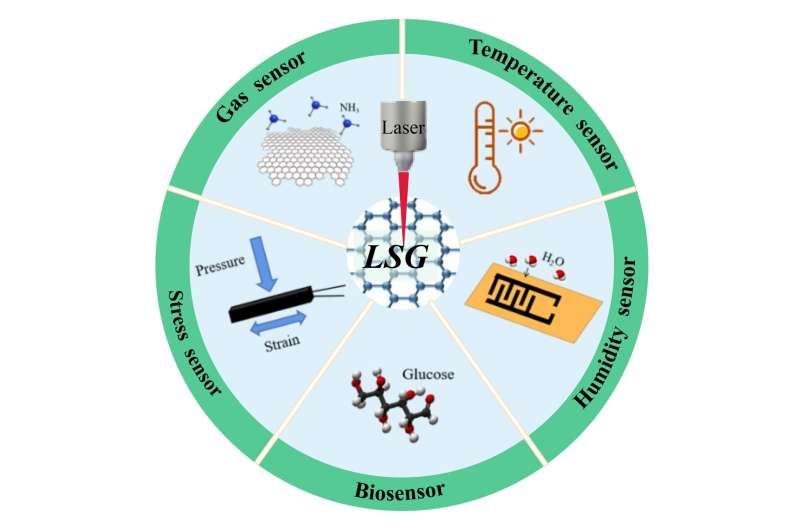This article has been reviewed according to Science X's editorial process and policies. Editors have highlighted the following attributes while ensuring the content's credibility:
fact-checked
proofread
Laser-scribed graphene for sensors

With the development of the information era, sensors capable of transmitting and detecting information have become the leading way to obtain information. Therefore, building a sensor system with a wide detection range, high sensitivity and fast response is essential.
Recently, graphene materials have received increasing attention for sensor applications due to their excellent electrical conductivity and physical, optical, thermal, and structural properties. These applications mainly include the detection of physical properties such as pressure and mechanical strain, chemical substances such as glucose, dopamine, proteins, heavy metals and organic pollutants, as well as the detection of gas, temperature and humidity.
In a new paper published in Light: Advanced Manufacturing, scientists led by Doctor Zhengfen Wang and Professor Xi Chen from the University of Shanghai for Science and Technology have reviewed laser-scribed graphene (LSG) for sensor fabrication.
Graphene has been prepared with various methods, such as mechanical exfoliation, chemical vapor deposition (CVD), epitaxial growth, and chemical reduction of graphene oxide. High-quality graphene can be obtained by mechanical exfoliation, but the low efficiency prevents the large-scale production of graphene.
The CVD method is considered the most promising method for preparing large areas and high-quality graphene, but the CVD method is constrained by high energy consumption and cost. Graphene films prepared by the epitaxial growth method have good electrical conductivity and high optical transmittance. However, they require high-temperature processing, energy consumption and transfer cost. Chemical reduction of graphene oxide is low in cost and high in efficiency but creates environmental pollution problems during the preparation process. Therefore, graphene's low-cost, high-efficiency, pollution-free preparation methods remain very interesting.
The laser direct writing technique has recently attracted research applications in various fields due to its unique advantages of selective and localized reduction, precise and fast patterning, and the absence of masks and additional chemicals. With the laser direct writing technique, a laser is used to irradiate the carbon precursors and generate graphene by in-situ scribing. The whole laser scribing process takes only a few minutes, which significantly improves the efficiency of preparing graphene.
The excellent properties of high surface area, high thermal stability, and high electrical conductivity exhibited by LSG films have led to its use in a wide variety of applications. Those applications include photodetectors, sensing, energy storage, memristors, holography, antibacterial applications and antennas.
The research team discussed the preparation and modification of LSG, which can be prepared by different laser light sources and precursors, including carbon precursors such as GO and PI. Conventional graphene preparation methods are energy-intensive, costly, or environmentally unfriendly, but this laser scribing method for graphene preparation overcomes these drawbacks. The LSG can be modified in one step by adjusting the laser parameters, atmosphere, and doping. The high surface area, good electrical conductivity, and simple and efficient fabrication process of LSG make it excellent potential for sensor applications.
The research team summarized the applications of LSG in stress sensors, biosensors, gas sensors, temperature sensors, and humidity sensors. The performance of the sensors can be optimized by using the appropriate laser power, scan speed, scan spacing, and suitable doping in the preparation of the LSG. For multifunctional sensors, the crosstalk between different signals can be reduced by structural designs and patterning. In particular, the flexible patterned preparation and various flexible substrates make LSG also promising for wearable sensor applications.
More information: Xing Liu et al, Laser-scribed graphene for sensors: preparation, modification, applications, and future prospects, Light: Advanced Manufacturing (2023). DOI: 10.37188/lam.2023.011
Provided by TranSpread




















